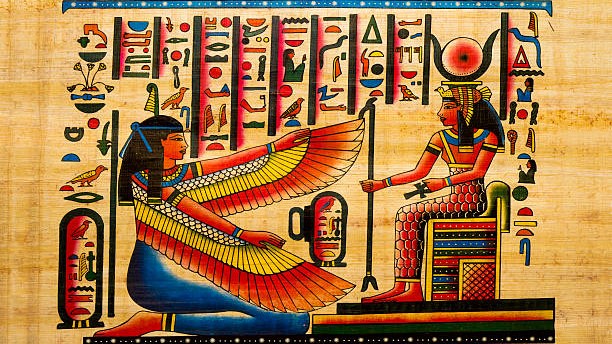Pantheon of Power: The Deities of Ancient Egypt
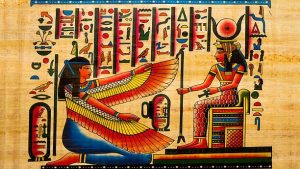
The God Ra
The god Ra is considered one of the most important ancient Egyptian gods. In the ancient Egyptian belief of Ashmunin doctrine, they believed that the universe was created from a cosmic egg or a lotus flower. The cosmic egg was from the ibis bird (Thoth) and from it emerged the deity Ra (the sun god). From the lotus flower emerged the god Ra in two forms, either as a scarab (Khepri) or as a small child (Nefertem). The ancient Egyptians considered the sun one of the most important sources of cosmic energy because the sun rises every morning and sets in the evening. The ancient Egyptians gave three names to the sun: Ra, Khepri, and Atum. Ra took three forms: at noon, he took the form of Ra as a sun disk. In the morning, he took the form of Khepri (the scarab). He took the form of Atum, an old man holding a stick, at sunset. The god Ra was depicted either as a sun disk or with a falcon’s head and a sun disk on his head surrounded by a serpent. He was worshiped since the beginning of Egyptian history and temples were built for him all over Egypt. His daily journey across the sky from sunrise to sunset represented the cycle of life, rebirth, and death, while his nightly journey through the underworld symbolized the renewal of the sun every morning. Ra not only represented the life-giving energy of the sun but also embodied the principles of creation and eternal renewal.
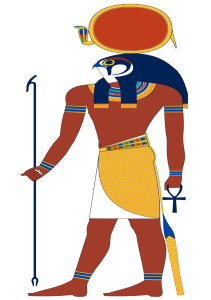
The god Ra with the head of a falcon surmounted by a sun disk
The God Ptah
In ancient Egyptian belief, the god Ptah was the creator god in the Memphite theology. His function was creation through the word, and the word always came from the heart before reaching the tongue. The god Ptah was considered one of the most important ancient Egyptian gods throughout the entire history of ancient Egyptian civilization, even up to the Greek and Roman periods. The god Ptah was also considered a god of arts, crafts, and industries. He was associated with the god of the dead in Saqqara (the god Sokar), so his name became “Ptah-Sokar” in Saqqara and he was considered a god of the dead. He formed a triad consisting of himself, his wife the goddess Sekhmet (a goddess of war, often depicted as a lioness), and their son Nefertem, who was always depicted as a child emerging from a lotus flower. Ptah was depicted as a human wearing a headdress topped with an Amun crown, holding a stick made of wood or stone.
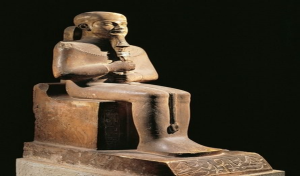
(Statue of the god Ptah – Egyptian Museum in Turin, Italy
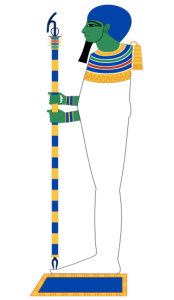
One of the forms of the deity Ptah, while wearing a robe and holding the was scepter
The God Aten
The worship of the god Aten appeared during the reign of King Akhenaten of the Eighteenth Dynasty. Akhenaten was a king, poet, and sensitive individual, considered more of a philosopher than a ruler. He called for the worship of the god Aten as the one and only god of the state. This idea was not customary in ancient Egyptian thought, which was accustomed to the existence of a group of gods. This idea was opposed by the priests of Amun-Ra in Thebes. Akhenaten decided to go to a new place to worship his new god Aten with his beautiful wife Nefertiti and their children. Aten is the sun god, but in Akhenaten’s thought, he is not only the sun god but also the center of truth and honesty. He was depicted as a sun disk from which rays ending in human hands. Akhenaten art was distinguished by its expression of truth. Akhenaten depicted himself in a way that combined the image of a sick man with that of a compassionate and affectionate human being with his wife and children. and changed the usual form of kings, which relied on idealism in depiction that hid the flaws of individuals. He established a complete city for the worship of the god Aten, which he named Akhet-Aten, meaning “Horizon of Aten,” and made it his capital to worship there with his beautiful wife Nefertiti and their children. King Akhenaten was depicted on the walls of the chambers, and murals were found on the outskirts of the city (Tell el-Amarna now in Minya Governorate). It is noteworthy that for the first time in ancient Egyptian history, a god did not take a triad, which indicates his uniqueness. He considered Aten the one and only one God. The worship of the god Aten did not continue after Akhenaten. Even his son Tutankhamun changed his name from Tutankhaten to Tutankhamun and returned to the worship of the god Amun-Ra in Thebes.
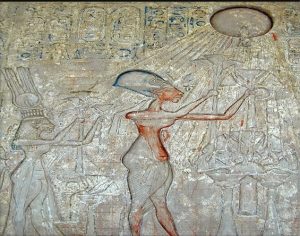
The god Aten appears in the form of a sun disk from its rays emerge, and end with human hands
The God Anubis
His name means “the royal son” because the myth states that the goddess Nephthys secretly gave birth to him from her brother Osiris. Fearing her husband Set, she placed him in the marshes. Anubis was secretly raised by the goddesses Nephthys and Isis. When Anubis grew up, he participated with Isis and Nephthys in mummifying the god Osiris. For this reason, Anubis became associated with cemeteries and the dead. Anubis was depicted as a jackal or a dog with the head of a jackal. He was always depicted in black, and sometimes as a human with the head of a jackal. One of Anubis’ most important functions was as a guardian of royal tombs. After a person’s death, Anubis participated in weighing the deceased’s heart before the god Osiris, in what is known as the Judgment of the Dead or the Osirian Judgment.
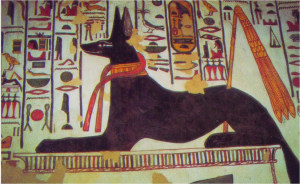
A view of the god Anubis from the tomb of Nefertari, depicting him running in the tomb

god Anubis depicted in the ritual of opening the mouth of the deceased from the Book of the Dead
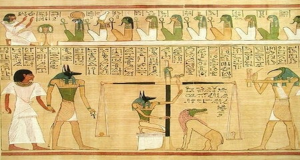
A scene depicting the god Anubis in the Osiris court

(Statue of Anubis from Tutankhamun’s tomb)
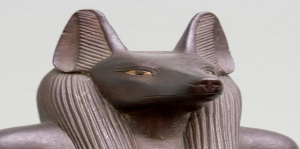
((A statue of Anubis dating back to the Late Period is on display at the Copenhagen Museum in Denmark
The Goddess Bastet
Bastet took the form of a cat, or a woman with the head of a cat. The ancient Egyptians would store grain, especially wheat and barley, in his house, but rats would spoil the grain. So, the ancient Egyptian raised cats inside the house to prey on rats, and for this reason, the ancient Egyptian loved them greatly and raised them in the house. When a cat died, the ancient Egyptians would initially bury it with them in their tombs, but later buried it in special tombs known as the tombs of Bastet’s cat, and it was mummified. Cats would play with children, and for this reason, they considered her a goddess of happiness, like the god Bes. The ancient Egyptians established a city for her and named it Bubastis which located in Sharqiya Governorate now. The ancient Egyptians made a festival for her, and her festival was the festival of happiness, and for this reason, it was the most Egyptian festival in which wine was drunk.
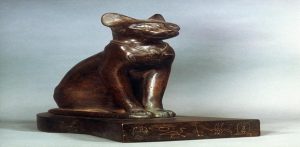
Statue of Bastet in Louvre Museum, Paris
The God Sobek
The Nile, along with the sun, played the most important roles in the life of the ancient Egyptian. The Nile brought water and sustenance, whether through fishing or using the water for agriculture. The ancient Egyptian feared the crocodile because it was the only animal that could obstruct his path while traveling between cities, as he relied on the Nile for transportation. The ancient Egyptians revered the crocodile and named it the god Sobek (the crocodile god). He was worshiped in a number of regions, most importantly Fayoum and Kom Ombo. The god Sobek was always depicted in the form of a crocodile or a man with the head of a crocodile.
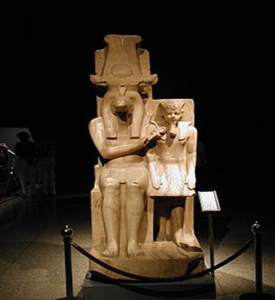
Statue of Sobek with Amenhotep III – Luxor Museum of Ancient Egyptian Art
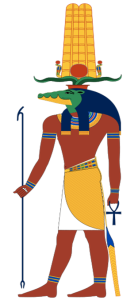
A view showing the appearance of the idol Sobek with the head of a crocodile
The God Hapi
Hapi is the god of the Nile. His name “Hapi” means “the happy one” or “happiness.” The god Hapi is one of the sons of the god Horus. and always depicted as a man with a female figure under his arm. The Nile, to the ancient Egyptians, was depicted as a man giving the flood which symbolizes fertility, while the female symbolizes the woman who breastfeeds her child. The worship of the god Hapi was known in ancient Egypt throughout the entire land. On the royal throne, Hapi always depicted on both sides , in what is known as the Sed festival (the unification of the two lands, meaning the north and the south). He was drawn tying the symbols of the Egyptian farmers, papyrus and lotus, in a column that starts from the heart. The heart refers to the Egyptian land, and the column refers to the Nile River. The festivals of the god Hapi were associated with the flood. Offerings were presented to him in celebration of the flood that gave Egypt its goodness and security. In some scenes, he is depicted in the sanctuaries while carrying the abundant goods of Egypt and offering them to the king and the gods. The god Hapi was depicted in the Holy of Holies. There are 42 scenes of Hapi offering offerings, and this refers to the 42 Egyptian provinces.
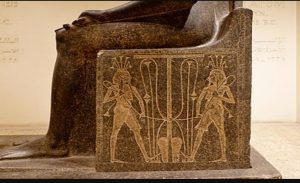
A scene depicting the god Hapi on the throne

The upper part of the statue of the god Hapi is displayed in Berlin

